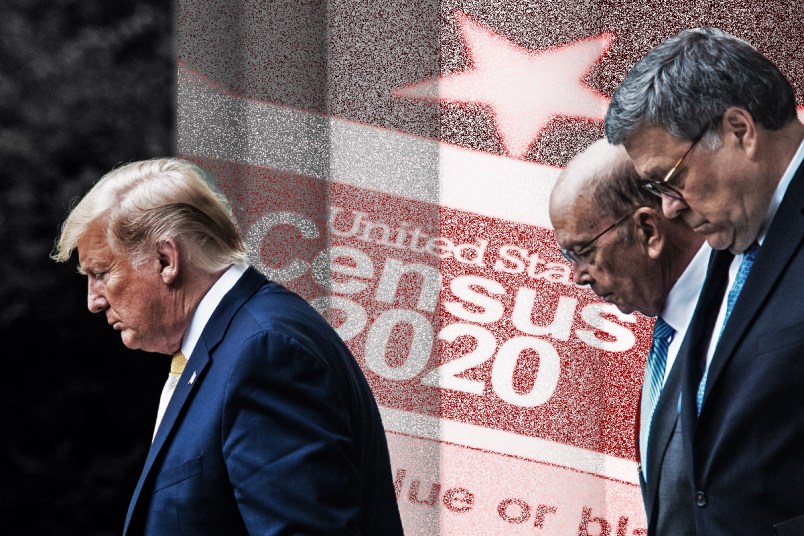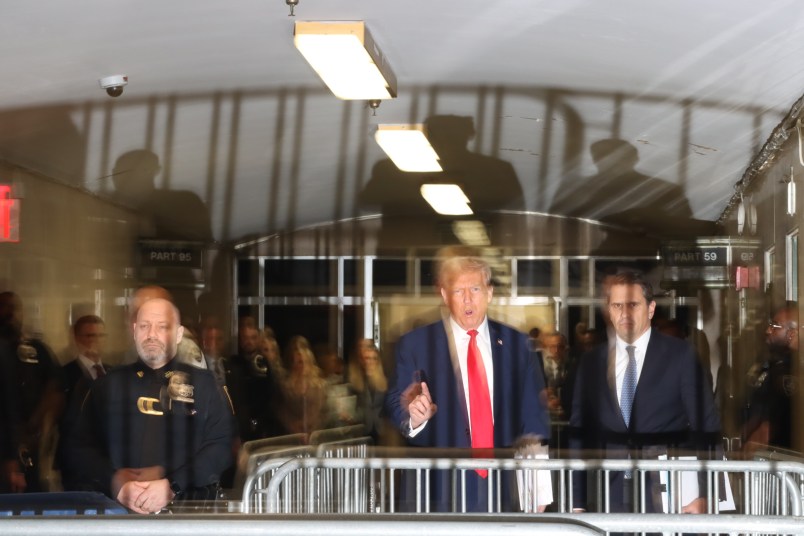Like so many episodes in the Trump era, one of the administration’s most audacious moves was first made public in a tweet.
Commerce Secretary Wilbur Ross was in a bind. At the time, a court order giving the Census Bureau more time to finish its count put in jeopardy Trump’s plan to fundamentally change how political power is doled out across the country. The President wanted to exclude undocumented immigrants from the congressional apportionment count, which would starve immigrant-friendly states of House seats while boosting the representation of whiter, more reliably Republican parts of the country.
But if the Census Bureau didn’t end its field work on the 2020 survey by Oct. 1, then those apportionment numbers might not be ready until after a Dec. 31 deadline that would allow for Trump to implement the policy before potentially a new administration would be coming in.
So in the face of a court order that threatened the timeline for pulling off the scheme, Secretary Ross got clever. He ordered — as announced in a Sept. 28 tweet — the Census Bureau to keep counting for just for five more days, even though the judge had intended for the Bureau to have an additional month. Ross settled on the date after Census Bureau officials told him it would allow Trump to get all the numbers his policy needed by Jan. 11.
The maneuver earned a tongue-lashing from the judge, who concluded that Ross had violated her order.
The dust-up was just one example of the lengths the Trump administration went to try to weaponize census data against immigrant political power. The gambits included multiple trips to the Supreme Court, drastic changes to census operations and the installation of several controversial Trump appointees at the top level of the Bureau, doubling the number of political appointees at an agency that has strived to separate itself from presidential politics.
But in the end, the wrangling was not enough. A perfect storm of a pandemic and litigation, of hubris and incompetence would derail Trump’s census efforts. And no amount of magical thinking or creative workarounds could overcome the logistical challenges that would put Trump’s hopes for manipulating the count out of reach. Time was not on the White House’s side, and, as sources inside and outside the agency told TPM, the administration had unreasonable expectations for what the bureau could do, given the COVID-19 outbreak and other complications to the count.
Even as that reality was becoming clear, concerns that the bureau’s work would be weaponized against immigrant political power lingered until the very end of the administration.
“We were vigilant until January 20. We had to be,” said Thomas Saenz, the president and general counsel for Mexican American Legal Defense and Educational Fund, which was on the frontlines of the fight against Trump’s bid to politicize census data.
The final days of the Trump presidency brought extraordinary public pushback by the Commerce Department’s inspector general, who aired whistleblower claims that they were being pressured to produce subpar data in the week before the inauguration.
Former Census Director Steve Dillingham — a Trump appointee who cut his term short by resigning after President Joe Biden was inaugurated – says the confrontation was fueled by a misunderstanding about the intent of the data request. Yet, in comments to TPM since stepping down, he also acknowledged that the larger political atmosphere around the census was the “greatest challenge” to the 2020 count.
‘They weren’t going to get it done by January 20.’
The writing may have been on the wall when the bureau put together its proposed timeline for producing the key data for Trump’s directive by the end of 2020. The agency had previously been under the impression that it would be given until April 2021 to produce the numbers. However, had that four-month extension been followed through, a Trump loss in November would have undermined his ability to implement the anti-immigrant policy.
(In court, the Justice Department claimed that congressional inaction on approving the extension was the reason for the reversal — a claim that was undercut by internal documents, an inspector general review, and TPM’s own reporting on the Hill).
The new proposal — leaked to the House Oversight Committee a month after it was presented to Secretary Ross in early August — gave little room for error and warned of the risks to the data’s quality. Outside census experts immediately recognized what a longshot the timeline was. In a press call with reporters in October, top career bureau officials acknowledged that any snags in the remaining procedures could put them behind schedule.
Sure enough, that possibility became a real threat by mid-November, when the bureau’s career experts vetting and processing the count’s data had found nearly a dozen issues in the numbers. As they told their leadership at a Nov. 18 meeting, resolving those snags would push back the release date of the apportionment data until at least late January.
Normally such “anomalies” wouldn’t cause much of a stir within the Bureau. But in the context of the short time Trump had left in office, the delays attracted national attention.
“Revealing the anomalies confirmed my expectation that there would be real problems that needed to be dealt with in a fashion that could not be rushed,” Rob Santos, the president of the American Statistical Association, told TPM.
The August move to speed up the count had prompted a lawsuit, in addition to the cases challenging Trump’s proposal to exclude undocumented immigrants from the apportionment base.
The challengers in the rushed count litigation fought aggressively to create a record of what the Census Bureau was doing to speed up the survey and how the career professionals were assessing any risks to the accuracy. Those discovery battles were extremely hostile, and required a team of judges that worked on weekends and holidays to settle the disputes.
“Once those documents got out there… it became clear to the people litigating the case that they weren’t going to get it done by January 20,” said Jon Greenbaum, the senior deputy director for the Lawyers’ Committee for Civil Rights under Law, which participated in the lawsuit.
‘Throwing women at a pregnancy’
Even before the revelation of the delays, the broader community of census advocates was on high alert for any signs of White House meddling in census operations.
In the spring and summer, the administration, without a heads up to the Census Bureau’s Trump-appointed director, had installed several political appointees to high-level posts at the agency.
By fall, White House was getting weekly briefings on the count’s progress — a break from past censuses, when such updates were given to the Commerce Department.
There’s been no indication that the administration considered pushing the bureau to release the numbers without first fixing the issues it had identified in November. But it did explore what other “resources,” in Dillingham’s words at the time, could be used to speed up the process. Tech specialists from Commerce and elsewhere in the government were brought in to look at how the procedures could be made more efficient.
However, the complicated stage of reviewing and processing the data relies on a small team of bureau experts, some of them with several years of experience in how to handle each step. Bringing in more people or money would only get you so far.
That approach was like “throwing women at a pregnancy to speed up the due date,” one outside census expert told TPM at the time.
The administration could only put off the admission of the logistical defeat for so long. At a Jan. 4 hearing in the rushed count litigation, a Justice Department attorney revealed that early February was the estimated delivery date for the state population counts that are used for apportionment. By then several more anomalies had been identified, and other documents had been leaked to the House indicating that a pre-inauguration release of the data was likely off the table.
The bureau is now saying it might take until April 30 to produce the apportionment counts.
One final blow up
This may have been the end of the story, had it not been for an exceptionally pointed letter to Dillingham that the Commerce Inspector General’s office released on Jan. 12. Inspector General Peggy Gustafson said that bureau whistleblowers had raised concerns about a demand from Dillingham and the newer Trump appointees at the bureau for a “technical report” on noncitizen data. Dillingham, according to the IG’s letter, had said that producing the report by Jan. 15 was a number one priority.
Hours before the letter’s release, Dillingham had already laid off that deadline, having been told by the top career official at the bureau that more time would be needed. The IG letter spurred him to call off the review for the data altogether.
The IG described Nathanial Cogley and Ben Overholt — two of the appointees the White House installed in 2020 — as the “driving force” behind the push. Civil rights groups believe that those appointees were hoping to walk away with at least some numbers that could be used in future GOP-aligned redistricting cases.
Dillingham said that his understanding was that the estimates could improve research around immigrant data in the country. The numbers would have only been released if they met the bureau’s standards, Dillingham told TPM. He insisted that even if they had been produced, they would not have been usable for Trump’s apportionment scheme, as the numbers were to cover legal non-citizens in each state.
Dillingham has refused to say who made the last-ditch request for the bureau to look into providing the estimates.
However, he has called for a change to the census schedule that would allow for the bulk of the decennial’s work to take place well before an election season gets underway.
“In my opinion, politics, not the pandemic, was the greatest challenge to the 2020 Census,” Dillingham said in an email to TPM.
The Census Bureau’s press shop declined to answer TPM’s questions about the IG matter or the other episodes of the final months of the Trump presidency.
“Any questions regarding the previous administration should be directed to those individuals,” a spokesperson told TPM.
Cogley also would not answer TPM’s questions about his time in the Bureau.
In an email, he cited the need to get clarification on his legal obligations to keep certain information private, as well as a distrust of the “same media that has tried to damage my reputation.”
“I was honored to have the opportunity to serve the USA, and in return have been treated to two rounds of false media smears,” he said. “To the contrary, I served with great integrity and offered good analysis and exceptional foresight.”










